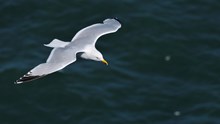06 February, 2024
New guidance to protect gull populations in serious decline

NatureScot has updated guidance for gull licensing in response to significant and serious declines in all five species that breed in Scotland.
The move will reduce the number of licences that are issued to control gulls in towns and cities each breeding season, following new evidence on the extent to which populations are struggling.
The latest Seabirds Count census shows that all five breeding species of gull continue to decline, with numbers in Scotland down by between 44% and 75% depending on species.
The declines are attributed to factors such as changes in food availability and land use, with some species also suffering losses because of recent devastating outbreaks of avian flu.
Currently, herring gull is a red listed species of conservation concern in the UK, while lesser black-backed gull, great black-backed gull, common gull and black-headed gull are all amber listed. A review of the classifications is underway following the latest Seabird Count publication.
In Scotland a specific licence must be applied for to destroy the nests or eggs of gulls, relocate chicks or, as a last resort, carry out lethal control.
Since removing gulls from the General Licence in 2019, NatureScot has been assessing demand for licenses while working with local authorities, pest controllers and the public to emphasise the requirement for preventative, non-lethal measures.
For the 2024 breeding season, in light of the latest population declines and the ongoing impact of avian flu, the guidance for applicants has been clarified further to ensure that applicants are aware that licences can only be issued for reasons of clear public health and safety issues, and where other alternatives are not effective. Applicants may be required to submit additional evidence before a licence will be issued.
NatureScot’s Licensing Manager Liz McLachlan said: “Our role is to balance the conservation and protection of species with public interests such as safeguarding people from health and safety risks. To make sure we get that balance right, it’s vital that our licences take into account the latest science and evidence.
“The ongoing declines in gull species in Scotland reported in the latest seabird census is very concerning. That’s why we are taking steps to ensure everyone is aware of our licensing approach, to ensure that populations are protected, and where possible restored, while health and safety risks to the public are minimised.
“We know that gulls can sometimes cause issues in our towns and cities and that these changes may cause concern for some people. Our licensing team have been communicating with local councils and licence holders to prepare them and we will continue to work with those affected as we enter the 2024 season to provide advice and support.”
ENDS
Contact information
- Name
- NatureScot Media
- Telephone
- 0131 316 2655
- media@nature.scot
Notes to editors
The latest Seabirds Count census from JNCC and partners published in November shows the following changes in Scottish gull populations since the last census in 2000:
- Common gull - Numbers have decreased by 53%. Predation and changes in land use causing degradation or loss of nesting habitat, along with food availability for coastal nesting birds, are likely to be the biggest drivers of change for this species. Scotland holds 89% of the British and Irish population.
- Black-headed gull - Declines in Scotland have been particularly severe, down by 75%. During Seabird 2000, 84% of the Scottish population bred inland but, by Seabirds Count, this had fallen to 44%, reflecting an 87% decline in the inland population. Declines in the coastal population have been less pronounced at 12%. Changes in land use and predation pressure are highlighted as main factors impacting upland sites in Scotland.
- Herring gull (naturally nesting) - Have declined by 44% with the largest declines along the west coast. Scotland holds half of British and Irish natural-nesting population, and Britain and Ireland as a whole hosts as much as 43% of the global population of this species.
- Lesser black-backed gull (naturally nesting) - Have declined by 48%, driven by decreases at coastal sites. Conversely, inland nesting lesser black-backed gulls in Scotland increased.
- Great black-backed gull - Have declined by 63% with the greatest declines in Scotland. Across the three prior censuses the breeding population in Scotland was relatively stable. Scotland holds 48% of the British and Irish population. The reasons for the more recent decline in Britain and, especially Scotland, are unclear but may be linked to changes in food availability.
Gulls have been affected by avian flu, with birds testing positive in both the breeding and non-breeding seasons. Work is ongoing to understand the extent of additional population declines as a result of the outbreak, but for all gull species considered there have been further decreases in their populations overall. In some cases, mortality has been recorded directly at breeding colonies, such as at Forvie National Nature Reserve where HPAI struck the black-headed gull colony towards the end of the 2023 breeding season, with mortalities occurring in both adults and juveniles.
NatureScot is Scotland's nature agency. We work to enhance our natural environment in Scotland and inspire everyone to care more about it. Our priority is a nature-rich future for Scotland and an effective response to the climate emergency. For more information, visit our website at www.nature.scot or follow us on X at https://x.com/NatureScot
’S e NatureScot buidheann nàdair na h-Alba. Bidh sinn a’ neartachadh àrainneachd na h-Alba agus a’ brosnachadh dhaoine gu barrachd suim a chur ann an nàdar. Tha e mar phrìomhachas againn gum bi nàdar na h-Alba beairteach agus gun dèilig sinn gu h-èifeachdach le èiginn na gnàth-shìde. Tha an tuilleadh fiosrachaidh aig www.nature.scot no air X aig https://x.com/NatureScot


